
by Maria Cristina Diaz, Harbor Branch Oceanographic Institute at Florida Atlantic University
Shirley Pomponi, Harbor Branch Oceanographic Institute at Florida Atlantic University
November 11, 2019
This has been quite an exciting expedition when it comes to sponges. We have seen, sampled, or collected in their entirety a number of particularly interesting and abundant sponges, some of which may represent new species or range extensions (i.e., we are seeing known species in places they have not been seen before) and that in some cases also have cultural or medical significance. We have highlighted a few of them below.

This glass sponge (Aphrocallistes beatrix) was seen during Dive 02 of the 2019 Southeastern U.S. Deep-sea Exploration. Image courtesy of the NOAA Office of Ocean Exploration and Research, 2019 Southeastern U.S. Deep-sea Exploration. Download larger version (jpg, 1.2 MB).
The iconic glass sponge Aphrocallistes beatrix is not only seen in abundance on these deep coral reefs but it is very important because of its potential human health benefits. In particular, this sponge has been found to contain a compound that may be able to help fight pancreatic and breast cancer.1
Aphrocallistes beatrix was first described (given a formal name based on extensive research) in 1858 following its discovery in the Strait of Malacca, which connects the Indian Ocean with the Pacific Ocean. Since then, it has been found around the world—from the deep waters of the North and South Atlantic Ocean (Florida, Brazil, the Azores) to those of the Indian Ocean and the Indo-West Pacific region.2
During the 2019 Southeastern U.S. Deep-sea Exploration, we encountered a few of these sponges with the species’ funnel-shaped form and semitransparent, sac-like outward projections. On some sponges, these projections are directed toward the seafloor, near the base of the sponge, and look like roots providing support for the main body.
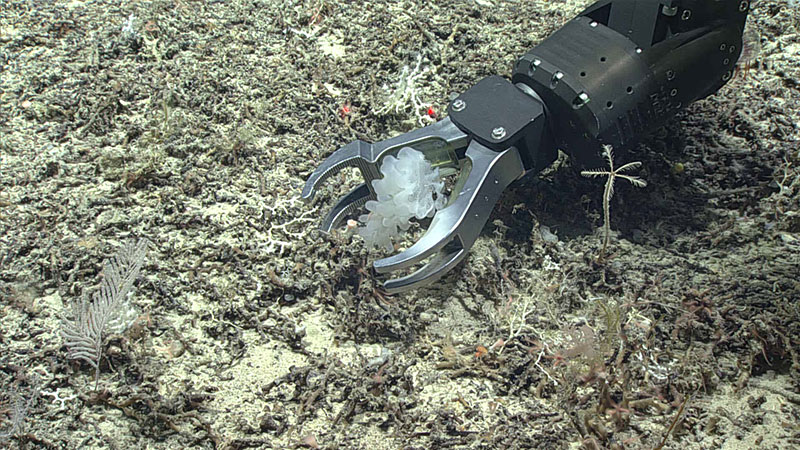
This glass sponge (Aphrocallistes beatrix) was collected during Dive 06 of the 2019 Southeastern U.S. Deep-sea Exploration. Image courtesy of the NOAA Office of Ocean Exploration and Research, 2019 Southeastern U.S. Deep-sea Exploration. Download larger version (jpg, 1.5 MB).
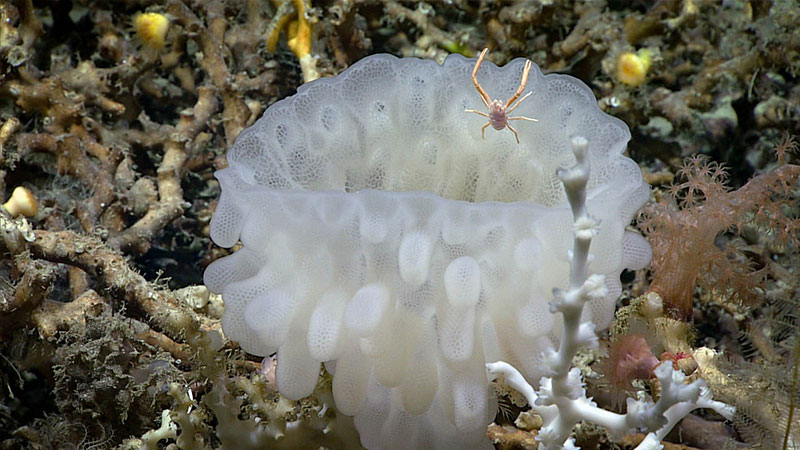
We also saw the glass sponge Aphrocallistes beatrix during the Windows to the Deep 2018 expedition, imaged here with a squat lobster. Image courtesy of the NOAA Office of Ocean Exploration and Research, Windows to the Deep 2018. Download larger version (jpg, 778 KB).
To date on this expedition, we have collected two samples of Aphrocallistes beatrix in support of the Atlantic Seafloor Partnership for Integrated Research and Exploration (ASPIRE). These samples will help the work of an international team of scientists in their efforts to learn more about the species, including how the different geographic populations of the species are related.
We have seen this glass sponge, as single and multiple tubes, on all our dives so far during this expedition. This means it has a widespread distribution and relatively high abundance (i.e., we have seen more than 10 specimens per dive). However, we are not able to identify the species as it is undescribed.
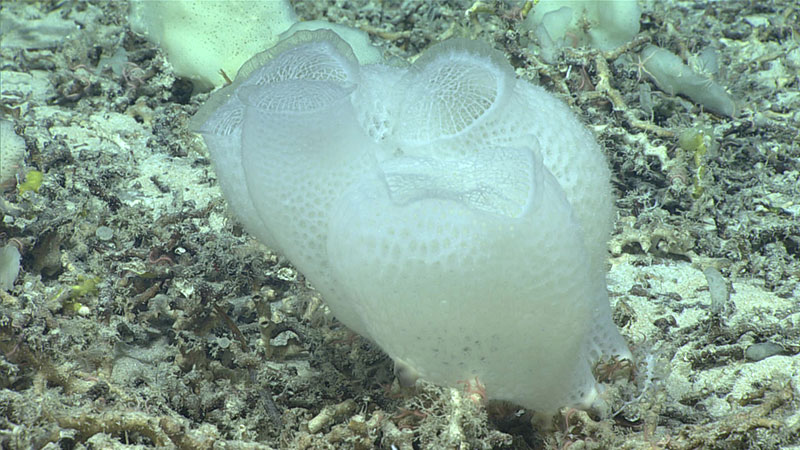
This glass sponge (Euplectellidae) was seen during Dive 05 of the 2019 Southeastern U.S. Deep-sea Exploration. Image courtesy of the NOAA Office of Ocean Exploration and Research, 2019 Southeastern U.S. Deep-sea Exploration. Download larger version (jpg, 1.1 MB).
What we do know is that it is in the family Euplectellidae. This is the same family as the famous Venus' flower basket sponge (Euplectella aspergillum), which was traditionally given as a wedding gift in Asian cultures. In Japan, this gift symbolized the idea of “till death do us part,” because a male and a female shrimp spend their entire lives together inside one of the sponge’s tubes (there is no way out of the sieve mesh at the top of the sponge body).
Our undescribed Venus’ flower basket sponge is not rooted to the seafloor; it is attached to rocks. In addition, it has long protruding spicules, microscopic needles made of silica that provide structural support and may fend off predators. Both of these characteristics give us some insight into its subfamily (Corbitellinae) and possible genera (Corbitella, Dictyaulus, or Heterotella).3
The only way we will be able to determine what genus it belongs to, and if it is indeed an undescribed species, is to carefully study its skeletal composition and arrangement. To help researchers learn more about this species, we collected a sample of it during Dive 04 of the expedition.
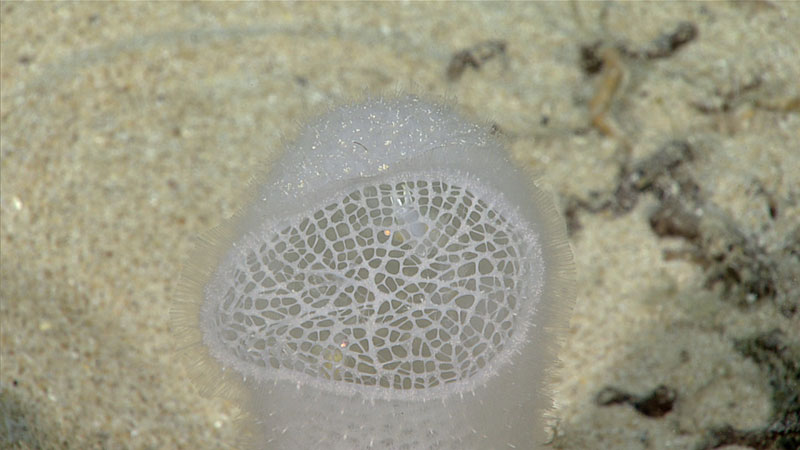
This glass sponge (Euplectellidae) was collected during Dive 04 of the 2019 Southeastern U.S. Deep-sea Exploration. If you look closely, you can see one of the shrimp that calls it home. Image courtesy of the NOAA Office of Ocean Exploration and Research, 2019 Southeastern U.S. Deep-sea Exploration. Download larger version (jpg, 681 KB).
Another sponge species that we have seen on multiple dives during this expedition is the demosponge Oceanapia sp. (of the order Haplosclerida and the family Phloeodictyidae). This genus is found living at a wide range of depths, from shallow mangrove roots to the deep sea. While there are 92 species of Oceanapia recognized in the world, we know of less than a dozen in the Tropical Western Atlantic, where this expedition is taking place.
We are unsure if this sponge has been described for the region or if it is new to science. To find out, we will need to study the dimension and shape of its spicules and its skeletal architecture.4 So, once again, we collected samples for additional research.
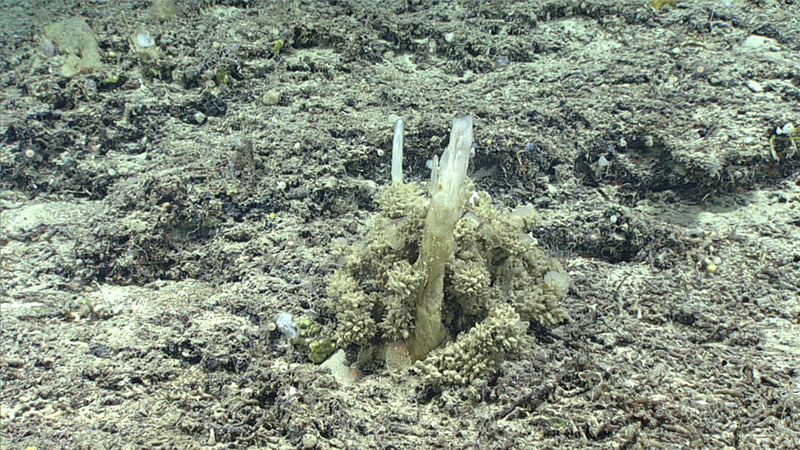
This demosponge (Oceanapia) was sampled during Dive 02 of the 2019 Southeastern U.S. Deep-sea Exploration. Image courtesy of the NOAA Office of Ocean Exploration and Research, 2019 Southeastern U.S. Deep-sea Exploration. Download larger version (jpg, 1.5 MB).
This peculiar species has a main fist-sized globular body that is buried under rubble or sand and two types of elongated projections that reach out into the water column to aid in feeding: one large, paper-thin cylindrical projection with an opening, an oscule, at its top and multiple tapering, thinner projections with no openings, called fistules.
The ability to live within sediments or rubble is called psammobiosis and is common to most Oceanapia species. Sponges like these have unusual ways to filter water and get their nutrients. In the case of this species, we suspect that water may come in through microscopic openings (called ostia) on the fistules and the buried sponge surface and be expelled through the oscule.
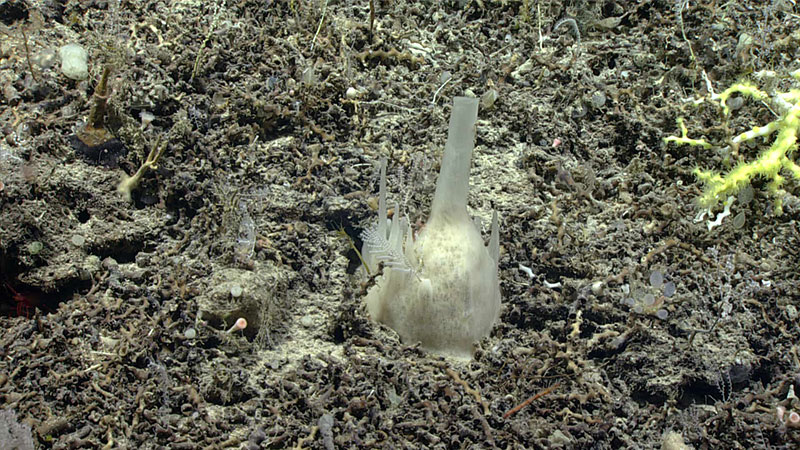
This demosponge (Oceanapia) was seen during Dive 02 of the 2019 Southeastern U.S. Deep-sea Exploration. Image courtesy of the NOAA Office of Ocean Exploration and Research, 2019 Southeastern U.S. Deep-sea Exploration. Download larger version (jpg, 1.4 MB).
1Wright et al. (2009). Isolation, synthesis, and biological activity of aphrocallistin, an adenine-substituted bromotyramine metabolite from the Hexactinellida sponge Aphrocallistes beatrix. J Nat Prod. 72(6):1178-83. doi: 0.1021/np900183v.
2Encyclopedia of Life.
3Personal communication with Henry Reiswig, November 2019.
4Personal communication with Rob Van Soest, November 2019.